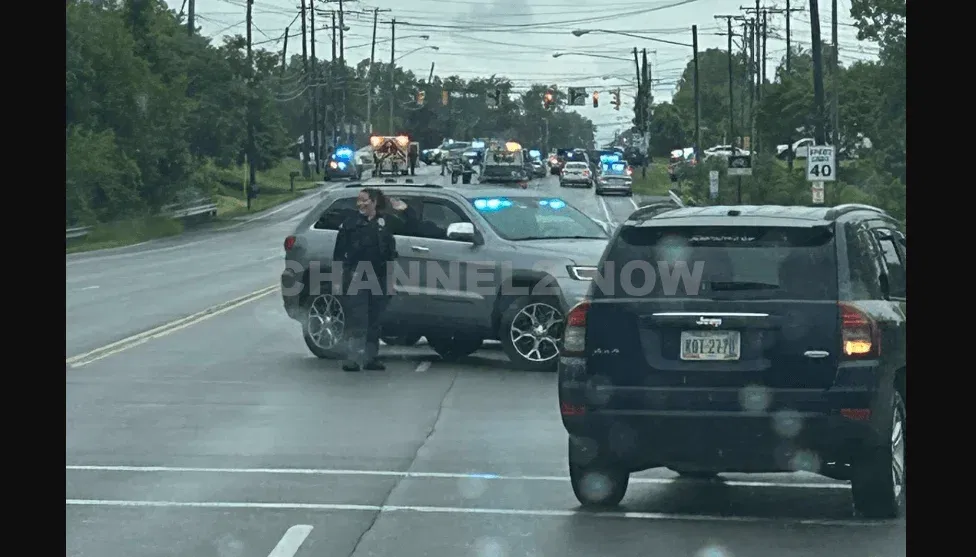LORAIN, OH — In a harrowing series of events that rocked the quiet suburban expanse of Lorain, Ohio, a road rage incident escalated into a violent and chaotic ordeal involving gunfire, a high-speed police chase, and a final crash that brought the pursuit to a screeching halt at the bustling intersection of Leavitt Road (State Route 58) and Meister Road. While investigations remain ongoing, the sequence of events that transpired on this day has left an indelible mark on the community and serves as a stark reminder of the volatility that can stem from impulsive aggression on the road.
The incident began with what authorities have so far characterized as an act of road rage. Though the precise trigger of the confrontation is still under examination, it is clear that what might have initially been a minor driving dispute quickly spiraled into a dangerous and life-threatening series of actions. Road rage, broadly defined as aggressive or violent behavior stemming from a driver’s uncontrolled anger at the actions of another motorist, has become a rising concern across the United States. According to data from the National Highway Traffic Safety Administration (NHTSA), aggressive driving plays a role in more than half of all traffic fatalities. In the Lorain case, the descent into violence was swift and devastating.
Witnesses to the unfolding events report that a suspect vehicle was traveling at an extraordinarily high speed—estimated to be between 80 and 100 miles per hour—northbound on Leavitt Road. This stretch of road, a key artery that leads toward the shores of Lake Erie, is no stranger to heavy traffic and is interspersed with residential neighborhoods and commercial zones. The danger posed by a speeding vehicle in this setting was immediate and extreme.
Eyewitnesses described scenes of panic as the suspect vehicle barreled through intersections and sped past other motorists, many of whom scrambled to get out of its path. The erratic driving, combined with the presence of multiple police cruisers in hot pursuit, brought a sense of surreal urgency to the usually mundane act of commuting. Some bystanders reported hearing the roar of engines and the blaring of police sirens long before they ever saw the vehicles involved.
The police pursuit, already dangerous due to the suspect’s high speed, became even more fraught when it became apparent that firearms were involved. According to initial reports, gunfire was exchanged during the course of the incident, though it remains unclear at what point shots were fired and by whom. The introduction of a firearm transformed an already perilous situation into one of heightened fear and risk for all involved, including the officers in pursuit, the suspect, and the public.
Gun violence in road rage cases is, tragically, not a new phenomenon. The American Psychological Association has identified a disturbing increase in the number of violent incidents linked to aggressive driving behaviors, with firearms frequently involved in the most severe cases. The ease of access to weapons, combined with heightened stress and a lack of impulse control, can often lead to explosive consequences.
As the suspect vehicle continued its reckless flight, it became clear that a confrontation was inevitable. The pursuit came to a dramatic and destructive end at the intersection of Leavitt and Meister Roads—a busy junction that sees considerable daily traffic. The exact details of the crash are still being pieced together by investigators, but the consequences were immediately visible: twisted metal, shattered glass, and a rapid deployment of emergency services to the scene.
Paramedics, firefighters, and additional law enforcement units converged on the crash site in an effort to render aid and secure the area. At this stage, authorities have not released information regarding injuries sustained during the crash or the status of the suspect involved. The chaotic nature of the chase and crash necessitated a rapid but careful response, with first responders navigating both physical debris and a tense, emotionally charged atmosphere.
In the aftermath of the crash, investigators began the painstaking process of reconstructing the events that led to the incident. This includes analyzing dashcam footage from police vehicles, collecting eyewitness testimonies, and examining the physical evidence left behind. Each piece of the puzzle is crucial in understanding not just what happened, but why it happened—and how similar tragedies might be prevented in the future.
Community members have expressed a mixture of shock, fear, and outrage in response to the incident. For many, the idea that such a violent episode could erupt in their own neighborhood is deeply unsettling. Leavitt Road and Meister Road are more than just coordinates on a map—they are daily routes to work, school, and home for countless residents. The violence that tore through this intersection has, for some, irrevocably changed the way they perceive their environment.
In the broader context, this incident touches upon several interrelated societal issues: the rise in road rage-related violence, the role of firearms in public safety, the challenges of policing high-speed chases, and the emotional toll such events take on communities. Each of these threads merits deeper exploration and sustained public attention.
Law enforcement agencies have long grappled with the complexities of vehicular pursuits. The decision to engage in a high-speed chase is never taken lightly. It involves a careful weighing of the risks to public safety against the imperative to apprehend a suspect who may pose an ongoing threat. In Lorain, officers made the call to pursue, likely based on the nature of the road rage incident and the involvement of a firearm. Their actions, now under routine internal review, reflect the difficult balance law enforcement must strike in moments of crisis.
As the investigation continues, one critical question looms large: how can such incidents be prevented? Public education campaigns on safe driving, legislative measures to curb aggressive driving behaviors, and community programs aimed at de-escalation may all play a role. Moreover, discussions about firearm access and responsible ownership are once again thrust into the spotlight.
Authorities have yet to release the identity of the suspect or provide specific details about any potential charges. It is expected that further updates will be shared once preliminary investigative findings are confirmed. In the meantime, residents are left to process a traumatic event that unfolded in their midst with little warning.
The collision at Leavitt and Meister Roads will be remembered not just for its dramatic visuals and tragic implications, but for the profound questions it raises about safety, accountability, and the human cost of unchecked rage. As Lorain mourns what could have been a far worse catastrophe, the urgency to address the underlying issues that led to this moment has never been clearer.
For now, the city watches and waits—seeking answers, demanding justice, and yearning for peace on the roads they travel every day.


Leave a Reply